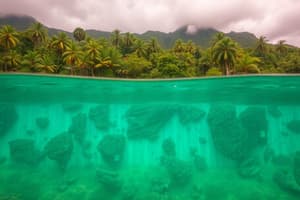Podcast
Questions and Answers
What type of climate is characterized by high temperatures and distinct wet and dry seasons?
What type of climate is characterized by high temperatures and distinct wet and dry seasons?
- Tropical Rainforest
- Mediterranean
- Tropical Savanna (correct)
- Desert
What is the average annual rainfall in a desert climate?
What is the average annual rainfall in a desert climate?
250mm (10 inches)
Which of the following climates experiences hot, dry summers and mild, wet winters?
Which of the following climates experiences hot, dry summers and mild, wet winters?
- Oceanic
- Humid Subtropical
- Mediterranean (correct)
- Tundra
The Ice Cap climate has high levels of annual precipitation.
The Ice Cap climate has high levels of annual precipitation.
What are the two main wind patterns mentioned in the document?
What are the two main wind patterns mentioned in the document?
A humid subtropical climate is characterized by hot, humid summers and high ______ levels.
A humid subtropical climate is characterized by hot, humid summers and high ______ levels.
What analysis helps in understanding the relationship between temperature and humidity levels?
What analysis helps in understanding the relationship between temperature and humidity levels?
Which climate condition refers to the effect of urban areas being much warmer than their rural surroundings?
Which climate condition refers to the effect of urban areas being much warmer than their rural surroundings?
What is the main goal of analyzing wind patterns in climate analysis?
What is the main goal of analyzing wind patterns in climate analysis?
Solar diagrams help in designing appropriate shading devices.
Solar diagrams help in designing appropriate shading devices.
Flashcards are hidden until you start studying
Study Notes
Tropical Climates
- Tropical Rainforest (af): High temperatures (20-25°C or 77-86°F), high humidity, stilt houses are common (similar to Bahay Kubo).
- Tropical Savanna (aw): High temperatures with distinct wet and dry seasons, pronounced seasonal precipitation variation, mug huts are found in Botswana.
Arid Climates
- Desert (BWh, BWk): Extremely low rainfall (less than 250mm or 10 inches), low humidity, clear skies, traditional houses in Iraq are examples.
- Steppe (BSh, BSk): Low to moderate rainfall (250-500mm or 10-20 inches), hot summers and cold winters, Mongolian yurts are a typical dwelling.
Temperate Climates
- Mediterranean (Csa, Csb): Hot, dry summers and mild, wet winters, frequent sunny weather, Roman Domus are an example of architecture.
- Oceanic (Cfb, Cfc): Mild temperatures with small seasonal variations, often cloudy and humid, consistent rainfall, Croft Houses in Scotland are representative.
- Humid Subtropical (Cfa, Cwa): Hot, humid summers, high humidity, significant rainfall, traditional Japanese houses are an example.
Continental Climates
- Warm Summer Continental (Dfa, Dwa): Warm to hot summers, moderate to high annual rainfall, significant seasonal temperature variation, log barn houses in Estonia.
- Cool Summer Continental (Dfb, Dwb): Cool summers, very cold winters, large annual temperature range, moderate precipitation, traditional Norwegian houses.
Polar Climates
- Tundra (Et): Extremely cold temperatures, low annual precipitation, permafrost in many areas, Icelandic turf houses are an example.
- Ice Cap (Ef): Perpetual ice and snow cover, very low precipitation, traditional Inuit houses (igloos).
Climatic Data and Analysis in Architecture
- Crucial for design; involves collecting, interpreting, and applying environmental information.
Climatic Data
- Temperature: Daily and seasonal variations are critical for achieving thermal comfort; understanding range is essential.
- Humidity: High levels are common in tropical areas, affecting comfort and material choices.
- Solar Radiation: Sun path (movement of sun across the sky) and solar intensity (amount of solar energy received) are key factors.
- Wind Patterns: Prevailing wind directions (e.g., Amihan (NE) cool and dry, Habagat (SW) warm and moist) influence ventilation design; speed and frequency affect openings’ design, orientation, and structural integrity.
- Rainfall: Amount and timing influence roof, drainage, and water infiltration management; monsoons and storms require structural consideration.
- Microclimate: Influenced by topography, vegetation, surface materials, water bodies, human activity, climate change; site-specific conditions (proximity to water, forests, urban areas) are important.
Climate Analysis
- Thermal Comfort Analysis: Identifying temperature and humidity levels using tools like psychometric charts to understand relationships between variables. Psychometric charts help illustrate and diagnose environmental problems like condensation.
- Solar Path and Shading Analysis: Analyzing sun path to design shading devices, window placement, building orientation using solar diagrams to optimize natural light and minimize heat gain.
- Wind Flow Analysis: Visualizing wind patterns to optimize building orientation, openings, and landscape design for natural ventilation.
- Site-Specific Microclimate Analysis: Understanding how terrain, trees, and other features affect local climate (shading, wind flow, temperature variations); considering urban density's impact on temperatures and designing to mitigate the urban heat island effect (cities significantly warmer than surrounding rural areas due to heat absorption and radiation from unshaded surfaces).
- Rainwater Management: Roof and drainage design to handle heavy rainfall; assessing rainwater harvesting potential based on rainfall patterns.
Studying That Suits You
Use AI to generate personalized quizzes and flashcards to suit your learning preferences.




